Disclosure: This article contains affiliate links and as an Amazon Associate, we earn from qualifying purchases made through our links.
One of the most irritating things happens when you come home after a long day and turn on your turntable or record player to relax, only to find out that the vinyl record is skipping.
I have been through this situation many times, but I still remember the first occurrence of this issue because it made me more stressed than the whole day working outside. I did a lot of brainstorming to find the reason why my record was skipping, but I still wasn’t able to fix it.
So, I reached out to my friends and did some research. After a while, I learned that this is a common problem and many people often face this issue, so I did more research and found out the culprit on my end.
In my case, the issue was with the counterweight. I don’t know how, but my little nephew has messed up the counterweight settings. I fixed it in no time, and soon after, my vinyl record was spinning on the turntable as it should be.
Well, that was my first time handling the record skips, but now, after handling several similar problems & getting so many other issues with my first cheap turntable because honestly, it was the only one I could afford and keeping it running for more than 15 years now- I have come a long way.
With my years of experience and more research, I have drafted this guide through which you can find the issue behind the record skip in your case and a step-by-step guide to fix vinyl record skipping and get your record spinning perfectly in no time.
But before jumping directly to the solutions, let’s first discuss what’s the reason behind the record player skips.

AT-LP60X-BK with Edifier R1280DB speakers
A beginner-friendly combo to kickstart your vinyl journey — no extra phono preamp or amplifier needed!
- Beginner-friendly
- Complete plug-and-play setup
- Fully automatic turntable
- High-fidelity sound
- Sleek design and easy to use
Why is my record skipping?
The stylus is one of the most important parts of a record player, which is responsible for fetching audio information from the grooves.
So, when a stylus at some point is unable to read the grooves and doesn’t send a vibration to the cartridge, then that part is considered a vinyl skip.
It is similar to driving a car at around 60 mph, and suddenly, a speed bump disrupts the car’s speed and ruins the smooth driving experience.
Now, one question arises: what causes a record to skip?
There can be many reasons behind a record skip, including imperfect turntable setup, dirty records, damaged stylus, worn-out mechanism, and more.
During my research, I noticed that people have mixed up all the possible reasons, which confused me a lot. So, to make things easier for you, I have categorized all the possible reasons and their solutions into two categories:
- Turntable or record player
- Vinyl record
Let’s find the reason behind the skip in your setup, and afterwards, we will look into solutions to fix it.
How to find the cause behind a skip:
As explained earlier, a vinyl skip can occur due to issues with either the turntable or the vinyl record.
And, to avoid trying every possible solution, we will first dig deeper and find the cause. Once we figure it out, we can fix the issue in no time.
There are two methods, and you can choose whichever suits you well.
- Trying different records on the same turntable setup.
- Try the same record on a different turntable setup.
Method 1 (Recommended):
Here, we will be playing 2-3 different vinyl records on the same turntable setup.
The idea behind this method is quite straightforward, i.e., if you hear vinyl skip on all records, then the culprit is the turntable, but if you don’t hear any skip on other records, then your record is the culprit.
Method 2:
Here, we will be playing our record on different setups.
You can either get help from your vinyl community friends or visit the nearest record shop. If you hear skips on different turntable setups, then your vinyl record is the culprit, however, if you don’t hear any skips, then you need to fix your turntable setup.
These are the two simple methods to figure out the reason behind a skip.
As you know, the culprit behind the skip at your end, you can choose the solutions category below and start trying solutions one by one.
How to fix a skipping record:
First, we will talk about different types of reasons and their solutions when a turntable or record player is the culprit.
Record skips due to the turntable or record player:
We have listed 10 different reasons and their solutions. I recommend that you start from the first reason and follow every solution until you find a fix.
Reason 1: Unstable record player’s base (Uneven desk)
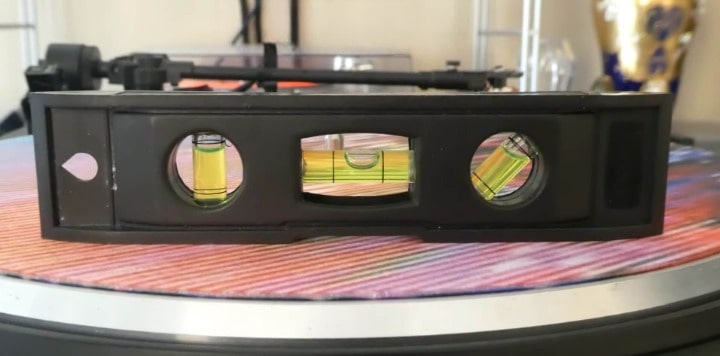
Sometimes unknowingly, we place turntables on uneven surfaces, such as tables or desks that wobble. The unsteadiness of the desk or table causes the turntable to vibrate while spinning the record on it, and due to this vibration, the stylus jumps off the record, which causes a skip.
To check whether the surface you placed the turntable on wobbles or not, you can try to move the table or desk gently, and if there is some movement, then you need to fix it.
Solution:
1) Replace the table with a new one, or you need to place some packing, such as shims or any other suitable object, under the table legs until it stops wobbling.
2) Place the turntable or record player on top.
3) Place a bubble level on the platter and try to level it horizontally. Most turntables have adjustable feet, allowing you to level them, but if your unit doesn’t have adjustable feet, then you need to take the necessary steps to level it.
The most cost-effective and proven method is to use playing cards from a deck, thin cardboard, or shims. I know these will look weird placed under your turntable, but you can always trim, spray paint, and glue them under the turntable feet.
That’s it.
Reason 2: Vibrations
Vibrations can travel from speakers, wobbling, and other media to the stylus. If you have wooden floors, then your footsteps near the turntable can create vibrations.
These vibrations cause the stylus to jump over the record. If the stylus jumps and lands on the same groove, then we call it a skip, however, if it jumps and lands on another groove, then we call it record skipping.
Solution:
You need to prevent vibrations from reaching your turntable stylus. To do so, follow this article: How to isolate a turntable from vibration.
Reason 3: The tonearm is not parallel to the platter

The tonearm must be parallel to the platter. In case of skips, most of the time, the counterweight dial is not putting sufficient weight on the tonearm, as a result, the tonearm is pointing upwards.
Solution:
We need to make the tonearm perfectly parallel with the platter as shown in the image below:

To do so, you can follow this guide: How to balance the tonearm.
Reason 4: Less tracking force
![]()
The tracking force is the weight that the tonearm puts on the record grooves through the stylus.
If the tracking force is too heavy, the tonearm will force the stylus to run deeper inside the grooves, which causes damage to records and the stylus, reducing their lifespan.
On the other hand, when the tracking force is too light, the stylus lacks sufficient weight to stay inside the grooves of the record, hence, it can either jump from one groove to another, causing a skip, or even scratch your record.
Solution:
First, check the recommended tracking force of the cartridge you are using and make the necessary adjustments. You can follow this guide to check and adjust the tracking force of the turntable.
Reason 5: Anti-skating Settings
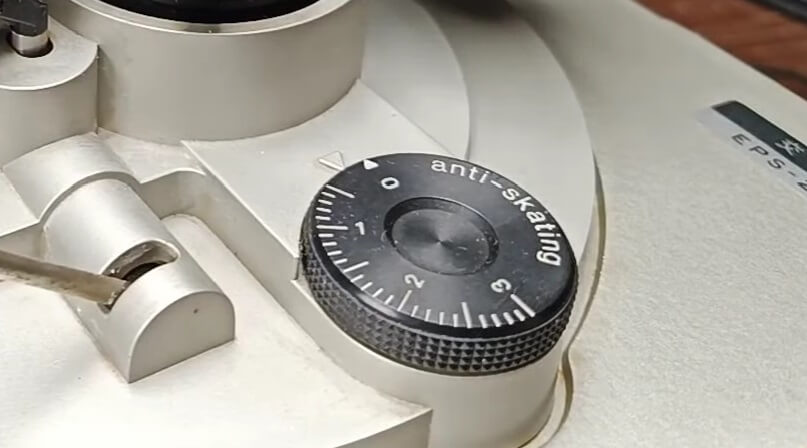
Anti-skating helps us in encountering natural skate force. It puts outward pressure on the tonearm and maintains a proper balance between inward and outward force, which helps in keeping the stylus in the center of the grooves.
If your anti-skating settings are incorrect, then you might encounter skipping issues or even damage to your records or stylus.
Solution:
All you need to do is set the anti-skating settings equal to the tracking force of your cartridge, and you’re done.
For example, if the tracking force of your cartridge is 2 grams, then set the anti-skating to 2 grams, and you are done.
That’s it.
Reason 6: Tonearm & anti-skating mechanism worn out
After all, a turntable and a record player are mechanical devices, so it is not surprising that their mechanisms can wear out.
The tonearm, along with its anti-skating feature and tracking force, is responsible for keeping the stylus inside the groove and stabilizing it.
If the mechanism of any component is worn out, then you will start facing a lot of issues, and skipping records is one of them.
So, to check whether the mechanism is working perfectly fine or needs replacement, you can follow the steps below:
Tonearm mechanism
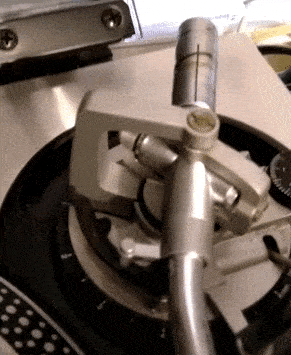
First, ensure that all the steps required to set up a turntable are completed with perfection.
After that, try to gently move the tonearm from its pivot point (the place where the tonearm is attached to the platter).
If you feel some play, you need to replace the bearings or even the whole tonearm. This issue is also known as tonearm rattle.
Anti-skating mechanism
To check the anti-skating mechanism, follow these steps:
1) Unplug the unit from the power source & remove the record from the turntable if it is there.
2) Set the anti-skating to 0 and lift the tonearm.
3) Gently, move the tonearm over the platter and ensure it is perfectly parallel to the platter. (We have provided a step-by-step guide for tonearm adjustment above.)
4) Once the tonearm starts hovering freely over the platter, you need to move the tonearm to the center of the platter gently.
5) Let the tonearm stabilize in its position, then turn the anti-skating dial to the maximum number.
6) If the tonearm starts moving away from the center to the side of the turntable, then your anti-skating mechanism is good. However, if the tonearm stays at the same place or makes a little movement, then you need to get your anti-skating mechanism changed.
These two mechanisms can be the main reasons why your record skips.
Reason 7: Issues with the stylus
You must make a habit of cleaning and tracking the remaining lifespan of the stylus regularly, as the stylus is the main component responsible for generating the sound from the record.
The stylus makes contact with the groove and generates electrical signals, which then travel to the preamp through the turntable cartridge and tonearm.
If you don’t remember the month or day you last cleaned your stylus, then I think the stylus could be the reason for skipping in your case.
There can be just two reasons:
- Dirty Stylus
- Damaged Stylus
Dirty stylus:
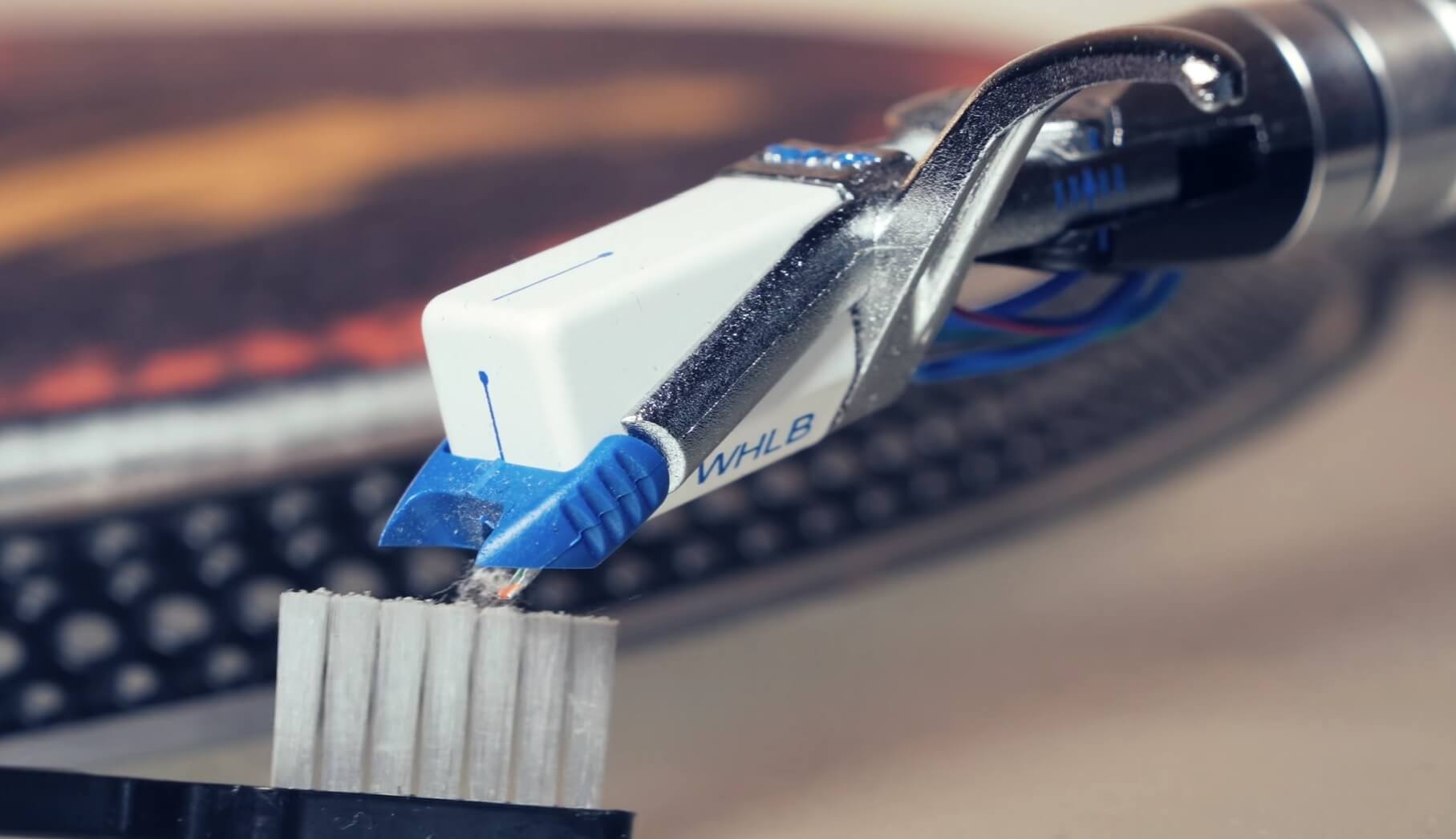
Simple, use a small brush and remove the dirt. Make sure you are not rubbing the brush on the needle.
The recommended method to clean a stylus is to move the brush from the back to the front and in an upward direction, as shown in the image above.
Damaged stylus:
The damaged stylus can also cause skipping. The stylus can get damaged due to improper handling, or it can wear out naturally.
Here, from the term improper handling, I mean that I have seen some people often try to balance the tonearm, re-position the turntable, level the turntable, and much more without putting the stylus guard and their stylus bounces on the platter or turntable body multiple times with causes dents and cracks on the tip.
In both cases, i.e., damage due to improper handling or natural wear and tear, you need to replace the stylus.
Now, the question arises: except for damage due to improper handling, how do I know that the stylus is worn out?
I am sharing two methods that you can use to check the damage to your stylus.
Method 1:
Everything in this world has a lifespan, and so does the stylus. The average lifespan of the normal stylus is around 1000-1200 hours of playing, whereas a diamond stylus can last a little longer, i.e., around 1800-2000 hours.
If you can track your playing hours, then you can estimate the remaining lifespan of your needle accordingly, but if you don’t like tracking your playing time, then I recommend you, change your stylus after a few months of using it.
You can take an idea from this: If you are a light user, you can replace it after 1 to 1.5 years, but in case you are a heavy user, then I recommend changing your stylus in about 7-8 months.
Method 2:
This method is a bit tricky and may cause some pressure on your eyes. In this method, you need a magnifying glass and a bright light.
Now, place the stylus on a white surface and inspect for bends or cracks on the stylus using a magnifying glass. You can also take the help of a microscope.
Well, I already told you this is a tricky method. I normally follow the 1st method because it is quite easy and better for the eyes.
Reason 8: Motor Belt
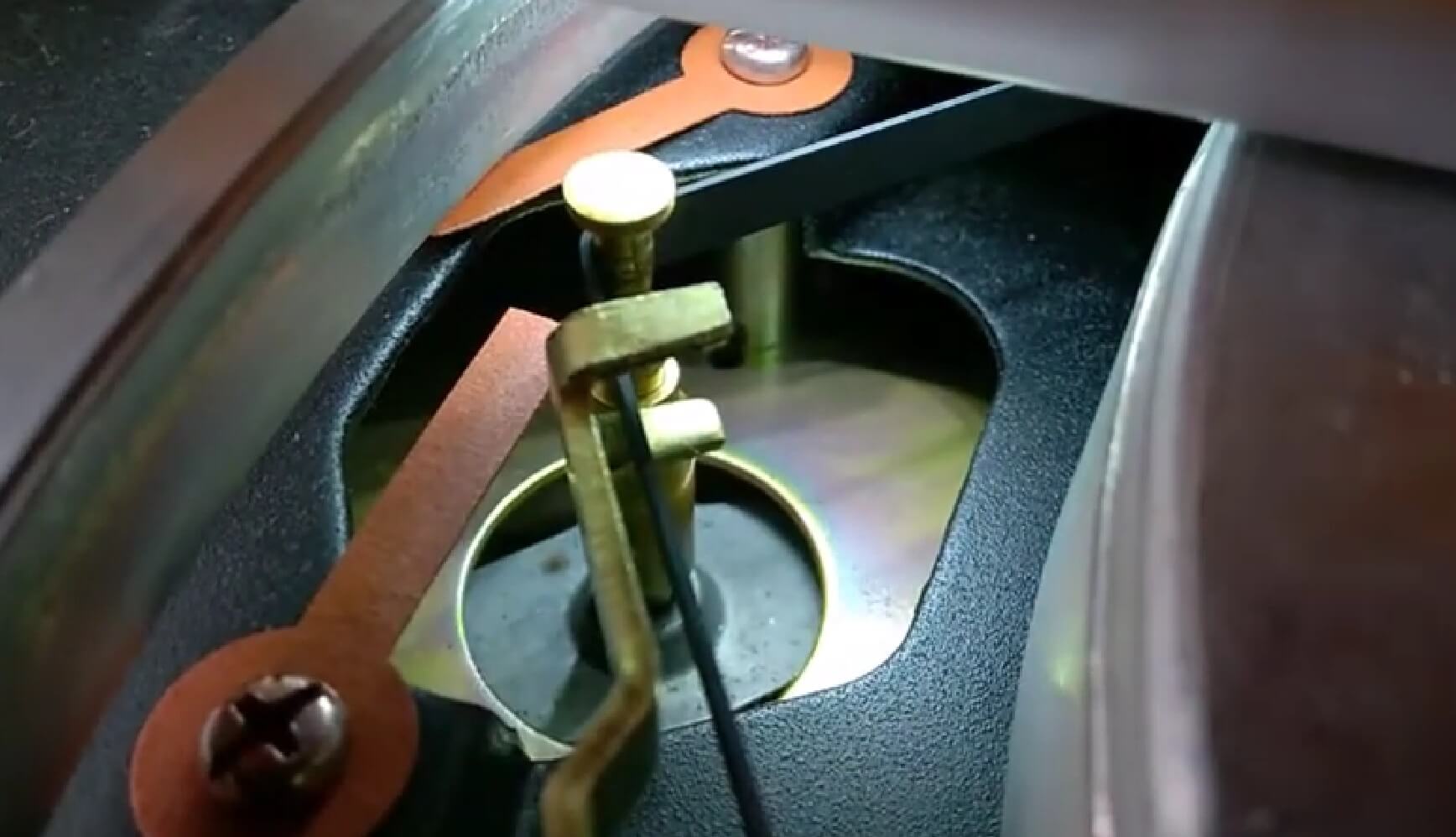
If you are using a belt-driven unit, then you should also check the belt of the motor. As I already told you, everything has a specific lifespan, so you could be spinning your turntable or record player on a damaged or loose belt.
This damaged belt can cause your turntable to spin at an inconsistent speed, so I recommend you follow this guide to change the turntable belt or record player belt.
Reason 9: Tonearm rest
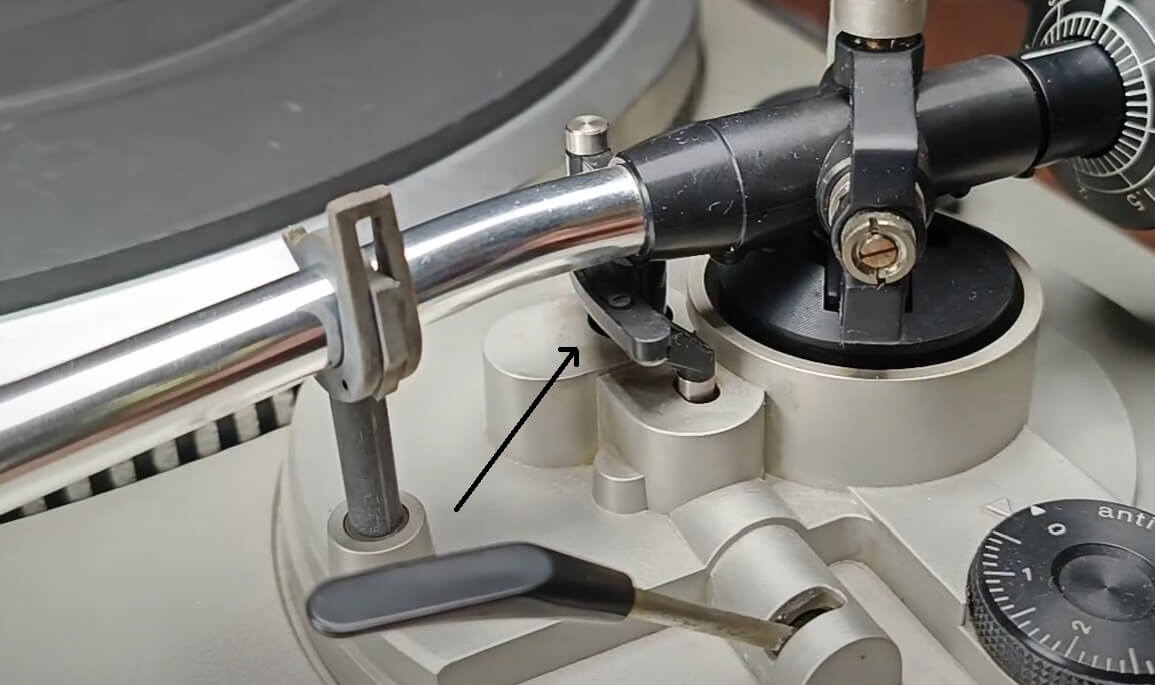
Most of the time, the tonearm rest is the main reason that unwanted vinyl skipping or audio distortion occurs.
As the name indicates, a tonearm rest is a piece of plastic or rubber where the tonearm rests when you raise the cueing device or tonearm lift lever.
This might not be the cause in new turntables, but in old ones, this can cause a lot of problems.
So, what happens is that the lubrication in the tonearm rest either dries out or becomes a lot stickier. So, when you move the cueing device downwards, the tonearm rest doesn’t go all the way down as it is supposed to, and the stylus is unable to reach inside grooves, causing an unwanted skip.
Solution:
There are 2 fixes for this issue:
Temporary Fix:

In this method, an additional step is added between placing your records on the turntable and playing them.
After you move the cueing device downwards, you need to manually apply some pressure on the tonearm rest so that it fully engages with the turntable, like it is supposed to.
This method itself solves the problem, but you must remember to do it before playing the turntable every time.
Permanent Fix:
The permanent fix is to remove the bad lubricant from the tonearm rest, clean it, and again add good-quality lubrication to it. This will fix the problem permanently.
Reason 10: Bad quality record players
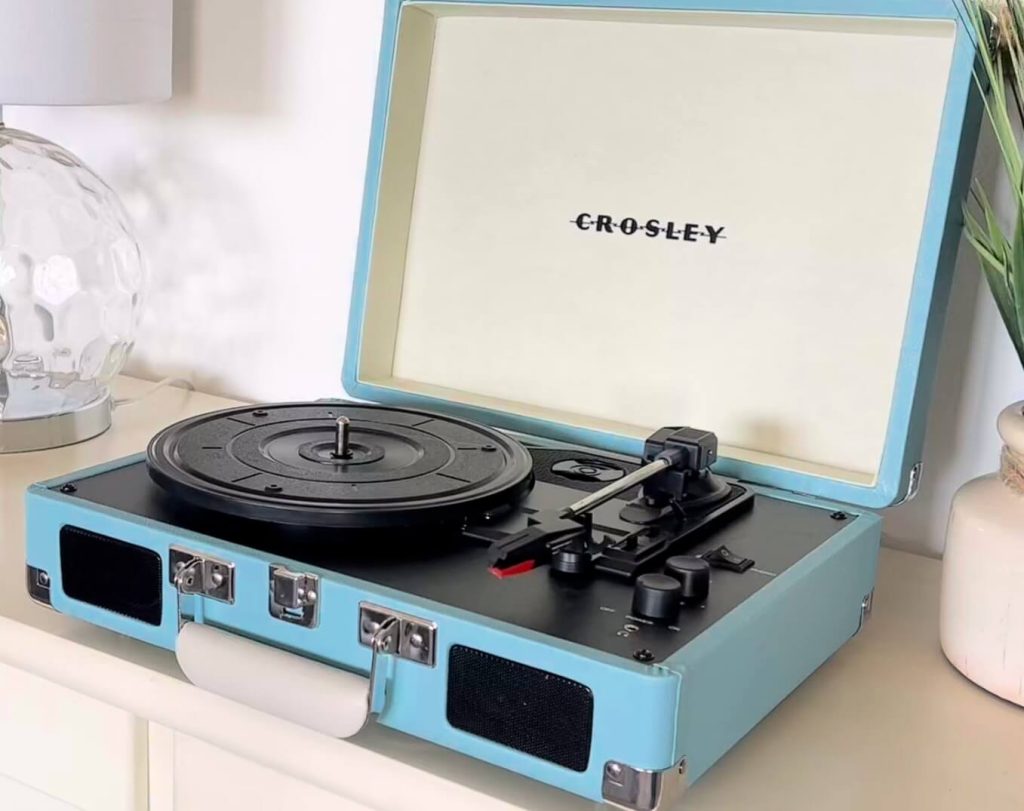
I’m not a big fan of all-in-one record players like Victrola or Crosley record players.
These record players are available for under $80, and this pricing indirectly tells you about the quality of materials used in them.
Let’s not discuss these record players here again. If you have a curiosity to learn about them, then you can check the following articles:
We have also compared both record players. You can check out Crosley vs Victrola.
Fix the record skip due to vinyl records
We have listed 5 different reasons and their solutions. I recommend that you start from the first reason and follow every solution until you find a fix.
Reason 1: Warped Records
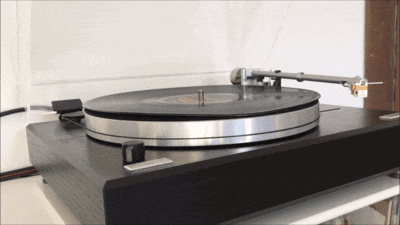
Warped records don’t let the stylus run efficiently inside the record grooves, and even a small bump can cause it to jump.
Solution:
We have already talked about warped records and shared proven methods that you can use to fix your records easily. Follow this guide: How to fix warped vinyl records.
Reason 2: Scratched Records
Scratches are the most heartbreaking thing that can happen to your vinyl because we can always unwarp a record using multiple methods, but once your record is scratched, it is permanent.
Scratches destroy the grooves, and these restrict the stylus from running freely inside the record grooves.
If you have deep groove scratches, then there is not much you can do to fix them. I recommend you buy a copy of your scratched vinyl.
However, if the scratches are not too deep, then we have a solution for you.
Solution:
Here are the requirements to proceed with the solution:
- Toothpick
- Cleaning solution
- Magnifying Glass
After getting these things, you can follow the steps mentioned below:
1) First, you need to check the direction of the scratch for the stylus, i.e., forward skip or backward skip.
2) Apply a few drops of cleaning solution on the scratched area. The reason for adding the solution is to provide lubrication for the toothpicks, thereby avoiding further scratches.
3) If it is a forward skip scratch, use the magnifying glass and apply gentle backward pressure on the scratch, or if it is a backward skip scratch, then apply gentle forward pressure.
4) Repeat the steps multiple times, and you will get your scratches repaired.
This method requires a great deal of patience and focus. That’s it.
My Experience:
I have tried this method and it works. I have fixed many records.
But now, if my record gets scratched, then I buy a new copy.
After fixing the scratches, the record becomes playable again, but it is just playable. The scratches are not entirely fixed, which may cause damage to the stylus.
Currently, I am using an expensive moving coil cartridge, so I don’t want to damage it.
Hence, I choose to spend a little and get myself a brand-new copy of the scratched record.
Reason 3: Dust or Dirt
Solution:
You need to clean your record and remove the dirt stuck inside the record grooves. I recommend checking out this article, which explains the best way to clean vinyl records.
Reason 4: Static on Records
As you know, vinyl records are made from PVC (polyvinyl chloride) material, which is a natural insulator, and the static charge builds on it when it interacts with surrounding objects.
Static electricity builds up on your vinyl record due to the stylus, record sleeves, or even the temperature and humidity of the room. And these static charge causes pops, crackles, or even unwanted skipping.
Solution:
You need to remove the static from the records. We recommend checking out this article to learn how to remove static from vinyl records.
Reason 5: Bass Heavy Record
Typically, a bass-heavy record can cause a skipping problem when played on low-end units.
So, I recommend that you first check whether the turntable or cartridge is compatible with bass-heavy records.
If not, make the necessary adjustments, such as replacing the cartridge or stylus, and try playing it again.
Reason 6: Pressing Error
It’s quite rare, but yes, it does happen.
Sometimes, the record pressing is not up to standard due to reasons, such as the record stamper being worn out, re-released vinyl not created from the original recordings, or even records pressed using bad quality vinyl.
Solution:
You can’t do much. Get yourself a new copy. That’s it.
So, these are the reasons that cause a skip and their solution. Now, we are going to discuss common practices to prevent unwanted skips in the future.
How to prevent record skips in the future:
Here are the practices I follow to prevent vinyl skipping in the future.
Cleaning records regularly:
I usually shallow clean my records before each play using a regular record cleaning liquid and deep clean them using Spinclean along with a vinyl vac once I have played them more than 10 times.
Keeping records static-free:
I keep my records static-free by storing them in anti-static record sleeves and using an anti-static brush before each play.
Following proper storage techniques:
I first put my records inside anti-static record sleeves and then inside their paper sleeves. After that, I store them vertically in a cart, away from direct sunlight and humidity.
This is how you should store the records. Storing records horizontally is a terrible practice, and everyone should avoid it.
Handling records properly:
You should always hold your record from the edges with your thumb on the label. The goal is not to touch the record grooves with bare hands.
Turntable maintenance:
You should maintain your turntable, i.e., cleaning and oiling it at regular intervals. You must ensure that the parts of the turntable, i.e., stylus tip, bearing, wiring, tonearm, etc., are working fine.
Well, these are the five simple practices that I follow, and trust me, I haven’t faced any vinyl skip issues in the last seven years.
Frequently Asked Questions:
Q1- Is it normal for new records to skip?
No, it’s not normal.
If your brand-new vinyl record is skipping, then I suggest you first try playing a different record on the same setup and check for skips.
If you still encounter a skip on a different record, too, then there are some issues with your turntable setup, otherwise, your new vinyl record is problematic.
Make sure your record is not scratched, warped, or dirty, and static-free. If everything is good, then I suggest you buy a new copy.
Q2- Why is skipping in the same spot?
If your record skips in the same spot, then there could be a scratch or dirt stuck inside the record groove.
I recommend that you first deep clean your record and try again. If the problem persists, then I suggest buying a new copy of the record and saving your stylus from further damage.
Q3- Why does every record skip on my turntable except 180g records?
Well, if every single vinyl is skipping and the 180g vinyl is playing perfectly, then the problem might be with the cueing lever and tonearm rest lubrication.
As we all know, 180g records are significantly thicker than average vinyl. If the tonearm rest isn’t fully lowered after lowering the cueing lever, the stylus may be able to reach the grooves of 180g vinyl, but it won’t be able to reach the record grooves deep enough on an average record, which could result in vinyl skips.
There are two solutions to this problem:
- Manually apply some pressure to the tonearm rest until it reaches its fully extended position.
- Replace the bad lubrication with good-quality lubrication.
That’s it.
Q4- How to fix the record skip on the first track or song?
If your record skips only on the first track, then you need to adjust your anti-skate settings. My suggestion is to set anti-skating settings equal to the tracking force of your cartridge.
Q5- How to stop record skips when I walk?
If your vinyl is skipping whenever you walk near your turntable, then you need to follow the vibration isolation techniques. Well, the reason is that the vibrations are traveling from the floor up to the stylus.
In this case, wall-mounting your turntable or using a heavy table along with a vibration-isolation platform or feet under your turntable does a wonderful job. For best results, consider wall-mounting your turntable.
We have shared all the possible causes behind a record skip and shared the solution to fix it. I assure you, once you read the article completely, you won’t be asking yourself, “Why is my vinyl record skipping?” ever again.
That’s it. Please let me know in the comments about the problem you were experiencing with your turntable or vinyl and how you resolved it. If you have followed a unique method, then please share it with us.



Hi James,
I have been facing this issue for a very long time. I had read many articles, but I was not able to figure out the issue on my end. But your suggestion to lower down the tonearm rest manually has fixed my issue. You can’t even imagine how happy I am today.
But I think manually lowering the tonearm rest every time is very tough. Is there any permanent solution to this?
Hi Joshua, I am glad to help you out!
Yes, there is a permanent solution. You just need to remove the bad lubrication from that area and re-lubricate it properly.
That’s it.
I have four records with mild scratches, and I am using an Ortofon quintet blue cartridge on my turntable.
Should I remove scratches using the toothpick method that you mentioned above and play my records on an Ortofon quintet blue cartridge?
What’s your recommendation?
Hi Christian,
Well, it depends on you. If the records are expensive, then you can try playing them, but if they are cheap, then I suggest you buy new copies.
As I already mentioned in the article above, no matter how precise you are while fixing the scratched records, you still can’t restore them to their original state.
And, for this reason, I always try to buy new copies instead of playing the scratch-fixed records.